Eager to witness Ireland’s untamed beauty and thinking about how to see the best of the Wild Atlantic Way in 5 days?
It might seem daunting to condense such a legendary journey into a short span, but that’s where my local insights come in handy! I’ve put together a comprehensive 5-day itinerary focused on the stunning southern stretch of the Wild Atlantic Way.
This guide is perfect for any enthusiastic traveller who might be feeling a little overwhelmed about where to begin or what to include in such an epic road trip.
Even though the full trail might require more than five days, rest assured, this compact journey is packed full of Ireland’s iconic landscapes and breath-taking coastal vistas.
Let’s set off on this exhilarating adventure through the Emerald Isle together.
- Plan your Trip With My Favorite Resources
- What is the Wild Atlantic Way?
- Why visit the Wild Atlantic Way?
- How to get to the Wild Atlantic Way
- Best time to visit the Wild Atlantic Way
- How to travel the Wild Atlantic Way
- Where to stay along the Wild Atlantic Way
- Tips for planning your Wild Atlantic Road Trip
- Day 1 – Cork to Kenmare
- Day 2 – Kenmare to Killarney
- Day 3 – Killarney to Bunratty (via Dingle)
- Day 4 – Bunratty to Galway
- Day 5 – Galway to Westport (via Connemara)
*This post contains affiliate links, which may include Amazon affiliate links. To read more about affiliate links, please visit my Disclosure Policy page.
How to see the best of the Wild Atlantic Way in 5 Days
Below you will find a Wild Atlantic Way Itinerary covering the south section of this coastal route. You can see a lot of the Wild Atlantic Way in 5 days but not all of it. You could extend and make this a 10-day Ireland Itinerary but if you only have 5 days, this itinerary will help you see the best of the Wild Atlantic Way. I also give you some helpful hints and tips for planning a Wild Atlantic Way road trip.
What is the Wild Atlantic Way?
Ireland’s Wild Atlantic Way is a coastal touring route along the west coast. Created in 2014 by Failte Ireland, it has encouraged visitors to explore all corners of the coast.
If you are wondering “how long is the Wild Atlantic Way in Ireland?” it is 2500km from start to finish. And where does the Wild Atlantic Way start and end? This amazing coastal driving route extends from the Old Head of Kinsale in the south and Malin Head in the north, following the west coast along the Atlantic.
The Wild Atlantic Way Map showing points of interest.
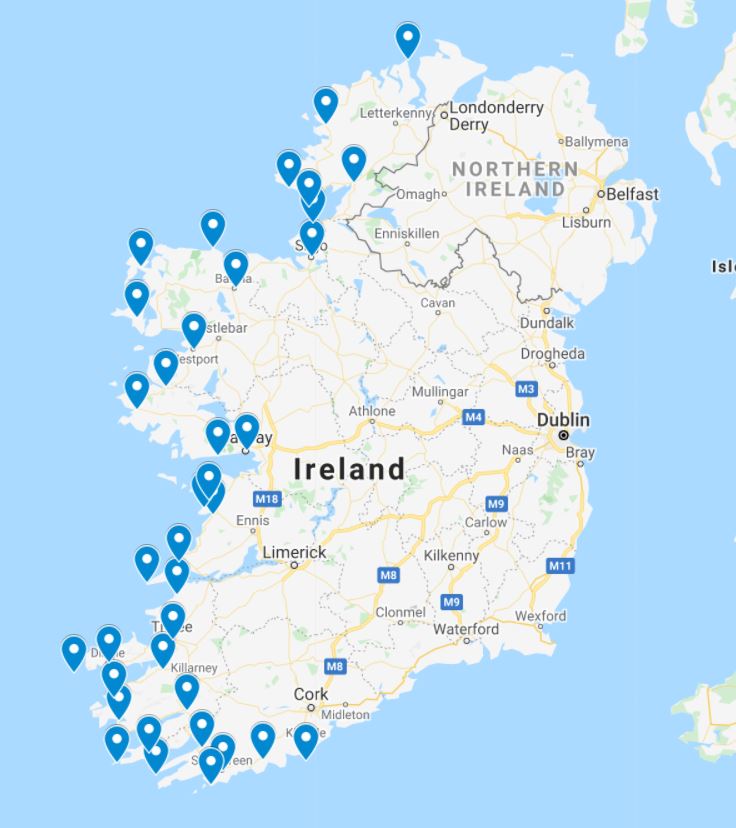
Why visit the Wild Atlantic Way?
The Wild Atlantic Way route follows the Atlantic coast of Ireland and passes through beautiful and varied places along the way including beautiful beaches and bays. It passes barren moorland and lush grassy fields, rivers, lakes, mountains and sheer rock sea cliffs. Along the way, you can meander down country roads, stop in quaint villages for a cuppa or hit the dizzying sights of bustling cities along the way.
The Wild Atlantic Way has something to offer every visitor, young and old. Between the natural beauty, friendly people, food, culture and heritage, you will find so much to see and do that even if you had a month to spend on the Wild Atlantic Way, you still wouldn’t cover it all.
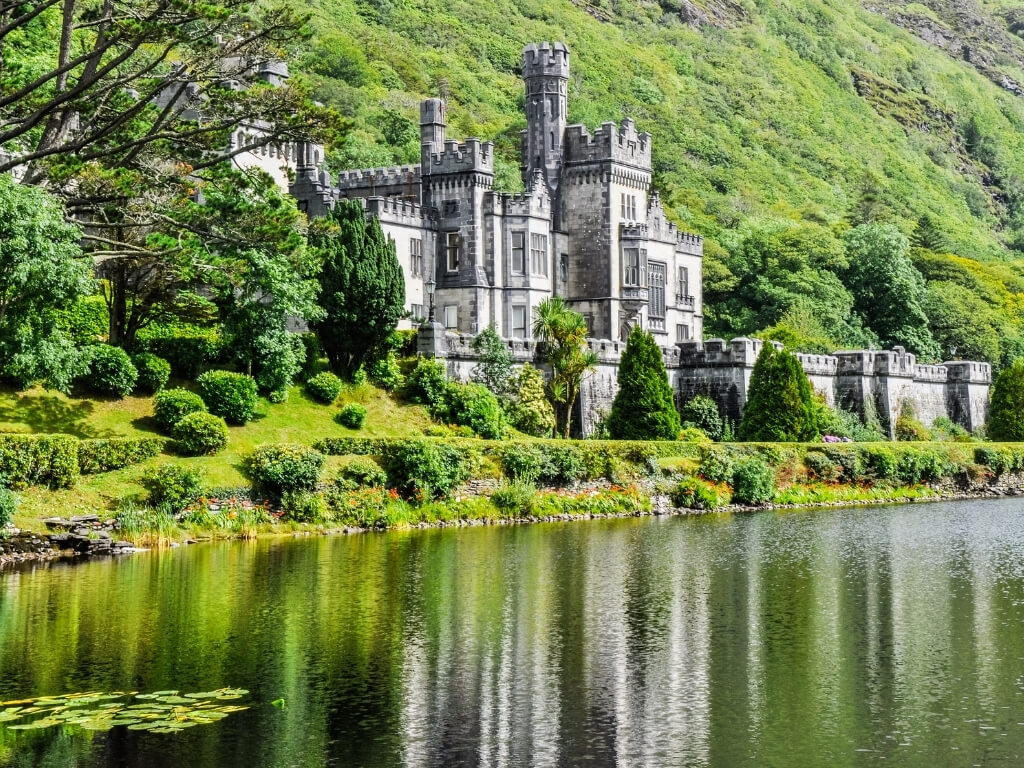
How to get to the Wild Atlantic Way
As already mentioned, the Wild Atlantic Way is located on the west coast of Ireland. The best way to enjoy it is to embark on a self-drive Wild Atlantic Way road trip, although there are companies who do Wild Atlantic Way tours.
To get to the Wild Atlantic Way, you are going to need to arrive in Ireland either by plane or by ferry. The ferry would be ideal if you are bringing your own car to use. We recommend using either Irish Ferries, Stena Line or P&O, depending on where you are coming from. Arrivals from Scotland are into Belfast, while arrivals from Wales are into both Rosslare and Dublin. Arrivals from France are into either Rosslare or Cork.
There are four main airports in Ireland (both Republic and Northern), and these are Dublin, Belfast, Cork and Shannon. If you are interested in this Wild Atlantic Way itinerary, then Dublin or Cork would be the ideal airport to arrive at. For exploring the northern half of the Wild Atlantic Way, Dublin, Belfast or Shannon would be best. You could fly into Shannon and head to Westport and do this south Wild Atlantic Way itinerary in reverse.
- Dublin to the Old Head of Kinsale – 304km, 3hr 30mins
- Cork to the Old Head of Kinsale – 36km, 45mins
- Dublin to Westport (for doing this itinerary in reverse) – 257km, 3hr 10mins
- Shannon to Westport (itinerary in reverse) – 164km, 2hrs
There are other regional airports that you could fly into but for ease of returning to your arrival airport, I recommend sticking with the main ones. This will also negate the need to pay one-way fees on your car hire. We recommend checking flights with Skyscanner.
Best time to visit the Wild Atlantic Way
Ireland’s Wild Atlantic Way can be visited at any time during the year but to try and make the most of your visit and try and get the best weather, a visit during the summer is recommended. That is not to say you won’t see rain or bad weather in summer. Ireland can get everything all in one day no matter what the time of year.
Summer is also when you can make the most of long days with plentiful daylight hours for driving and sightseeing along the way.
To give you an idea of weather and daylight hours and the best times of year to visit Ireland, read this post.
Some popular tourist destinations may become busy during summer, so if you want to avoid crowds, then going during spring and autumn may be better. Winter can also be a great time to drive the Wild Atlantic Way as roads and attractions will be quiet. However, days are quite short meaning you will need to cover your distances and stops within 8 hours, or thereabouts.
How to travel the Wild Atlantic Way
Unfortunately, public transport in Ireland, especially in rural areas, is sparse and limited. This means that driving the Wild Atlantic Way is a must. Many of the smaller roads and villages along the way may not be serviced by public transport and getting between the cities along the way can be challenging too, and potentially quite expensive.
Hiring a car and driving yourself is the easiest and most flexible option. There are Wild Atlantic Way signs along the route to help guide you, just make sure to stay left and take your time, particularly on narrow winding roads. We recommend checking hire car prices with rentalcars.com.
During summer, cycling the Wild Atlantic Way is another option but should only be undertaken if you are an experienced cyclist on narrow roads with little or no overtaking space. And walking the Wild Atlantic Way can be enjoyable along certain parts of the coast, so make time to stop and visit the coast on foot. You could even watch the sun go down.
Where to stay along the Wild Atlantic Way
There is an abundance of places to stay on the Wild Atlantic Way including campsites, B&B’s, hostels and more. There are also numerous hotels on the Wild Atlantic Way from budget-friendly hotels to luxurious 5-star hotels. No matter your budget or preference, you will find lots of accommodation to choose from.
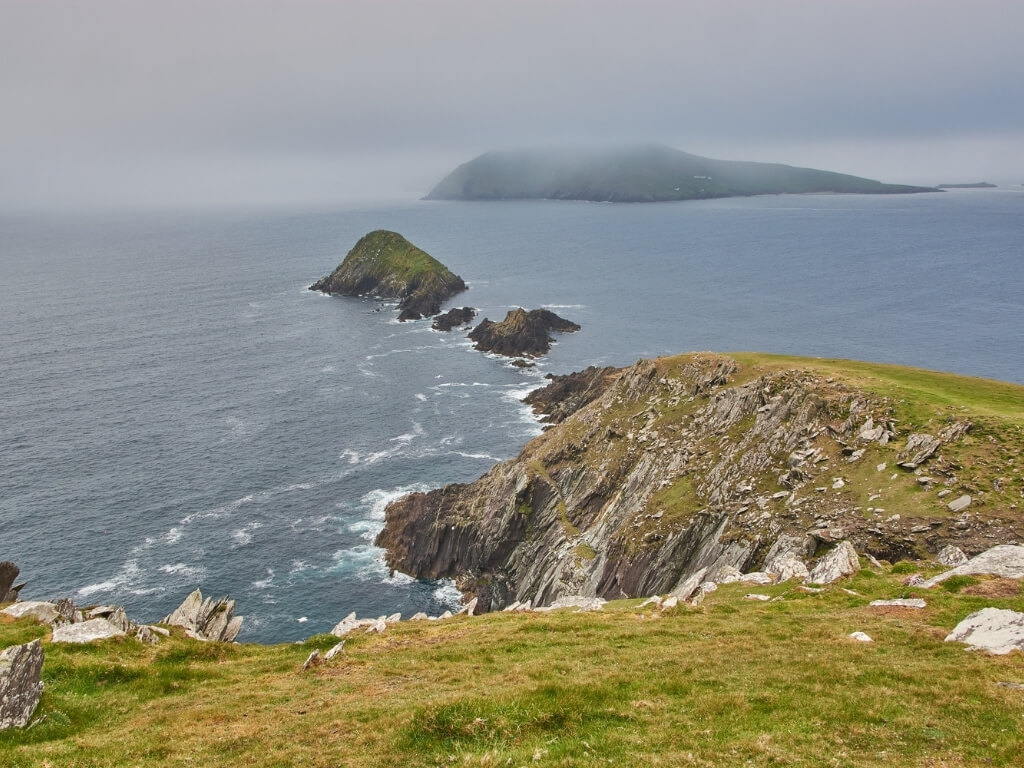
Tips for planning your Wild Atlantic Road Trip
Wild Atlantic Way discovery points – In total there are 188 discovery points along this amazing route. Of those, 15 have been designated signature discovery points as they represent some of the best known and most popular sites along the Wild Atlantic Way. They are
- Old Head of Kinsale, Cork
- Mizen Head, Cork
- Dursey Island, Cork
- Skelligs View, Kerry
- Blaskets View, Kerry
- Loop Head, Clare
- Cliffs of Moher, Clare
- Derrigimlagh, Galway
- Killary Harbour (south), Galway
- Keem Strand, Mayo
- Downpatrick Head, Mayo
- Mullaghmore Head, Sligo
- Slieve League, Donegal
- Fanad Head, Donegal
- Malin Head, Donegal
Wild Atlantic Way passport – Each discovery point along the route has a unique stamp that can be collected in the WAW Passport. This is a unique way of recording your journey along the world’s longest coastal touring route. The passport is a great way to get kids interested in the different points along the way, but that’s not to say this isn’t for adults as well.
If you’d like to start collecting your passport stamps along the Wild Atlantic Way, then grab this passport from An Post before you go. It costs just €10 plus postage and packaging, or you can buy it in any post office along the route.
Each stamp is available from the post offices along the way so remember to stop and get your passport stamped before you move on! If you miss a few you can pop into larger tourist offices in the bigger towns and cities and catch up. Just be aware that post offices close from Saturday afternoons and the tourist offices are generally closed on Sundays. You can check the opening times of post offices in the areas you will be visiting on the An Post website.
Wild Atlantic Way distances – Do not underestimate the distances between places along the Wild Atlantic Way. Although Ireland is a relatively small country, because this route follows smaller coastal roads and weaves and winds its way along with them, distances can be deceptively longer than you initially think. For this reason, I am including distances and an estimate of the time it will take to drive from point A to point B without stops to give you an idea of how long each day will be. This will help you plan your stops and day better.
Hiking the Wild Atlantic Way – There are lots of mountains, hills and ridges along the Wild Atlantic Way and if you enjoy hiking, then you will find plenty of opportunities to do it. Just add sufficient time to your itinerary for it though, especially if you are planning on following this Wild Atlantic Way itinerary.
Be aware that some hiking mountains are for more experienced hikers and make sure you go prepared for all types of weather. And ensure you have the correct footwear too.
5-Day Wild Atlantic Way Itinerary (South)
This itinerary will allow you to see some of the best Wild Atlantic Way highlights from Cork to Galway and more. This 5-day Wild Atlantic Way itinerary focuses on the southern half of the route and has days that are pretty full-on with driving.
Distances between points and estimated driving times are included to help give you an idea of the day ahead so you can plan what time to leave and stops along the way. Each day is also accompanied by a map of the Wild Atlantic Way section for that day.
Day 1 – Cork to Kenmare
Starting at the Old Head of Kinsale, you will be following the coast in County Cork to Kenmare, in County Kerry. This route is approximately 305km long and will take an estimated 6.5 hours at an average speed of less than 50kph.
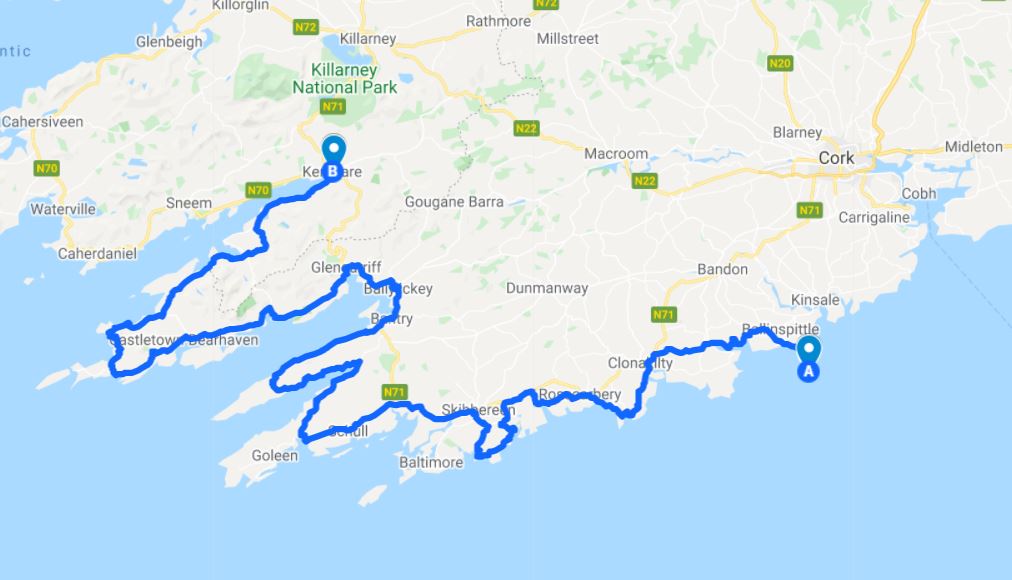
While you initially start bypassing grassy green fields, the terrain gets progressively rugged and wild. This is the beauty of West Cork. Sheltered harbours and coves give way to open cliffs, offshore islands and towns and villages that are pretty and picturesque.
From Kinsale you will follow the Wild Atlantic Way along the coast, winding through villages such as Clonakilty (famous for its cheese, white and black pudding, and some of the best sausages produced in Ireland), Skibbereen (which hosts an Arts Festival in July and whose heritage centre houses exhibitions on the Famine and ecology of a nearby lough), Bantry (a bustling town with formal gardens that span seven terraces) and on to Kenmare in County Kerry.
Along the way, you can decide to stop to take in incredible views or to visit certain places along the Wild Atlantic Way. Just make sure you factor time into your day for this. Things to see and do along this stretch of the Wild Atlantic Way include:
- Timoleague with its 13th century Franciscan Abbey.
- Drombeg Stone Circle, west of Rosscarbery.
- The 17th-century castle at Castletownshend.
- Baltimore with its Beacon and ferry journeys in summer to the island lying off the mainland.
- Mizen Head, the southwestern tip of Ireland, has a visitor’s centre and footbridge leading to the lighthouse which you can enter for a small fee.
- The Sheep’s Head Peninsula, a quiet place ideal for hikers and houses a lighthouse at the end of the peninsula.
- The Beara Peninsula, with its wild rugged, exposed rocks, open coastline, and craggy mountainsides. Visit the Garnish Island Gardens and the Glengarriff Nature Reserve.
Places to stay in Kenmare – For budget-friendly accommodation, check out The Lodge B&B or the Kenmare Fáilte Hostel. For hotels, we recommend the Brook Lane Hotel or the luxurious Park Hotel.
Click the blue links for latest prices and availability for The Lodge B&B, the Brook Lane Hotel or the Park Hotel.
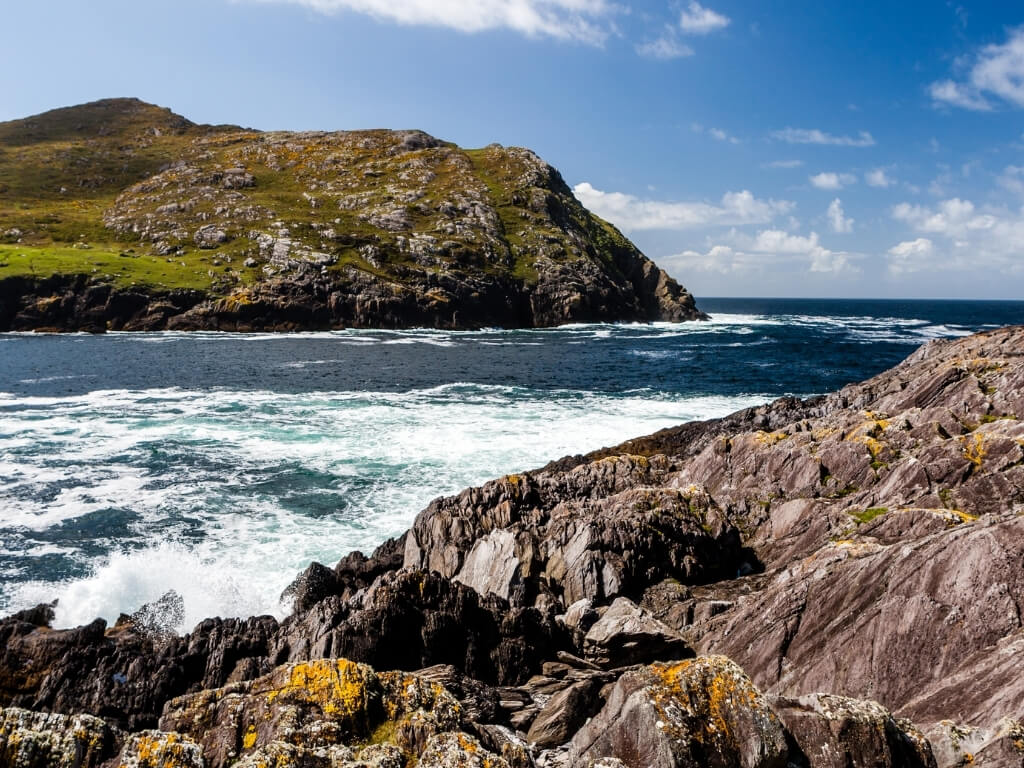
Day 2 – Kenmare to Killarney
Today is all about enjoying the Ring of Kerry in what is known as the Kingdom of Ireland. This section of the Wild Atlantic Way is approximately 172km long, will take 3.5 hours (without stops) at an average speed of just under 50kph. However, as there are lots to see and do along this route, we recommend you allow the whole day, and even then, you won’t fit it all in.
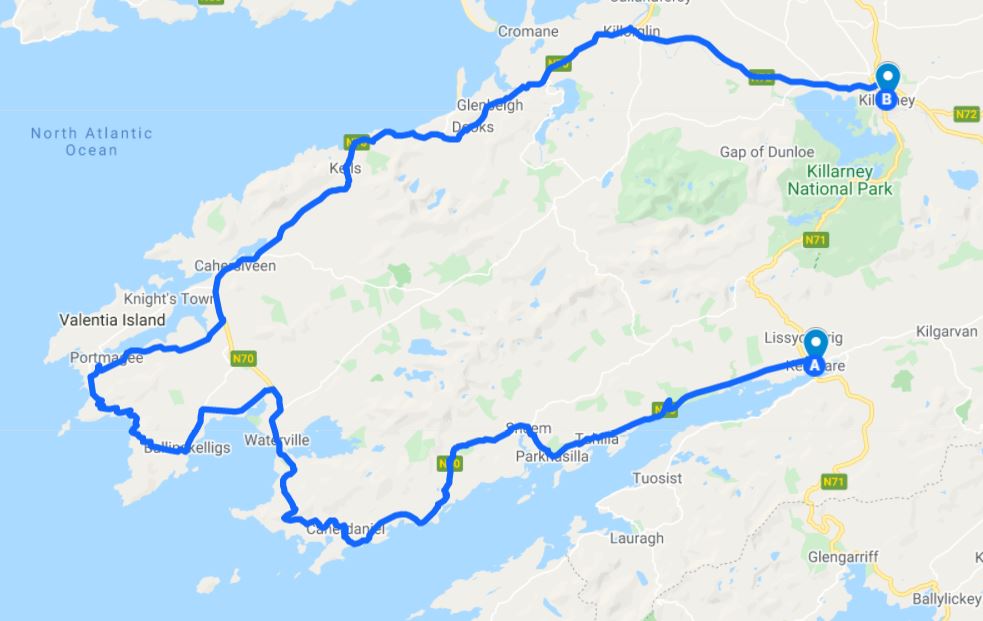
You will be departing Kenmare, an attractive small town and travelling west and then north around the Iveragh Peninsula. Since tour buses tend to follow an anti-clockwise route on the Ring of Kerry, travelling clockwise will help you avoid getting stuck behind them.
Villages you will pass through include Sneem (with two popular walking routes starting here), Ballinskelligs (with its Blue Flag beach and the 16th century McCarthy Mór Tower), Portmagee (a cute fishing village from where you can get boats to the Skellig Islands), and Killorglin (famous for its Puck Fair in August).
The views along this part of the Atlantic Coast are incredible and some parts along the route have pull-in places so you can get those all-important pictures. As well as driving this section of the Wild Atlantic Way, we highly recommend you continue on from Killarney to visit the Killarney National Park and places such as Ross Castle, Muckross House and Gardens, the Torc Waterfall and then drive inland to enjoy the landscape from Lady’s View and to visit the beautiful Gap of Dunloe. Given that you have a full day for this section you can allow time to visit these places. Alternatively, you could choose one of the following things to do along the Ring of Kerry.
- Visit O’Carroll’s Cove with its sandy beach.
- Visit the ancestral home of Daniel O’Connell, Derrynane House, near Caherdaniel.
- Stop in Saint Finian’s Bay to view the Skellig Islands and stock up on chocolate from Skellig’s Chocolate factory. Skelligschocolate.com
- Take the ferry from Portmagee to the Skellig Islands to visit the monastery on Skellig Michael.
- Drive across to Valentia Island and visit the Heritage Centre to learn about the transatlantic cable that went from there to Newfoundland.
- Spend time in the Killarney National Park as mentioned already.
Places to stay in Killarney – For a budget-friendly, comfortable stay we recommend the Killarney Oaks Hotel. Click here for prices and availability. For mid-range budgets, why not stay at the Killarney Towers Hotel. Check the latest prices and availability here. Or for a luxurious stay on the edge of the biggest lake in the Killarney National Park, we recommend The Europe. See this hotel and the latest prices and availability here.
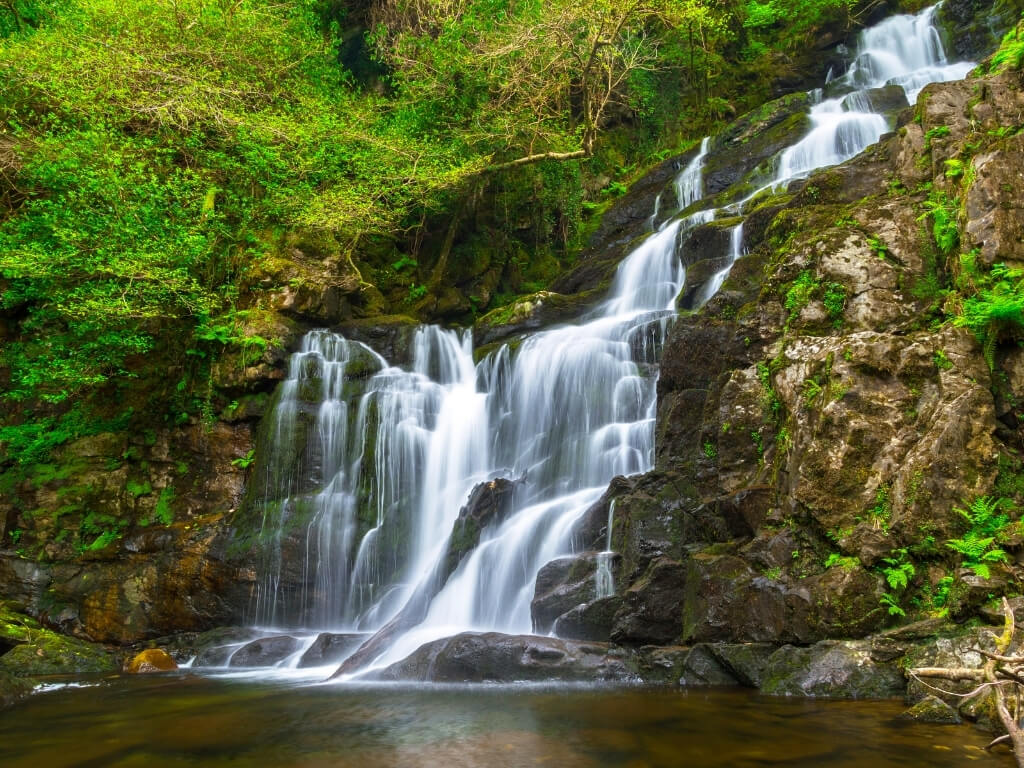
Day 3 – Killarney to Bunratty (via Dingle)
Today you will be heading north along the Wild Atlantic Way from Killarney to Bunratty in County Clare via the Dingle Peninsula. This section of the route is approximately 302km long, will take 5.25 hours without stops at an average speed of less than 60kph.
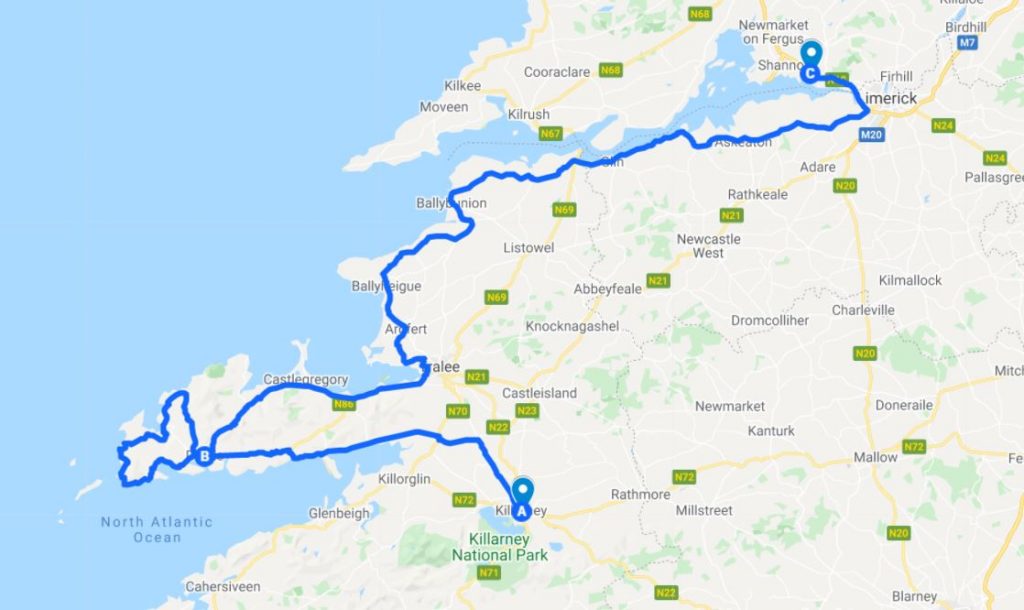
The Dingle Peninsula is one of the few Irish-speaking regions of Ireland and arguably one of the most beautiful. With beautiful beaches, rolling grassy green fields, mountains, a rugged coastline and more, it is easy to see why visitors fall in love with the Dingle Peninsula.
Leaving Killarney, you will head for Dingle town, a busy seaside town (enjoy fish and chips and an ice-cream by the sea), before moving through the Slea Head Drive and then onto Tralee. Continuing north past the seaside town of Ballybunion and onto Bunratty in County Clare.
This section of the Wild Atlantic Way is mainly about scenery and landscape but there are still a few things to do along the way to break up the driving.
- Visit Dunquin, the most westerly village in mainland Europe and enjoy views across to the Blasket Islands, a popular destination for day-trippers from Dingle in the summertime.
- Visit the early Christian church of Gallarus Oratory, which dates back over 1000 years, near An Mhuiríoch.
- Visit Brandon Bay which is home to Ireland’s longest beach.
- See the 6th-century monastic site of Rattoo near Ballyduff which has a round tower, church, abbey and cemetery.
- Stop at the historic Carrig Island and see the ruined 15th-century castle of Carrigafoyle.
Places to stay in Bunratty – For budget-friendly accommodation not far from Bunratty Castle, stay at the Shannon Springs Hotel. Click here for the latest prices and availability. Or stay opposite the Bunratty Castle in the Bunratty Castle Hotel. Find the latest prices and availability here. Make sure to ask about tickets to the Medieval Banquet for the night of your stay, as it is a must!
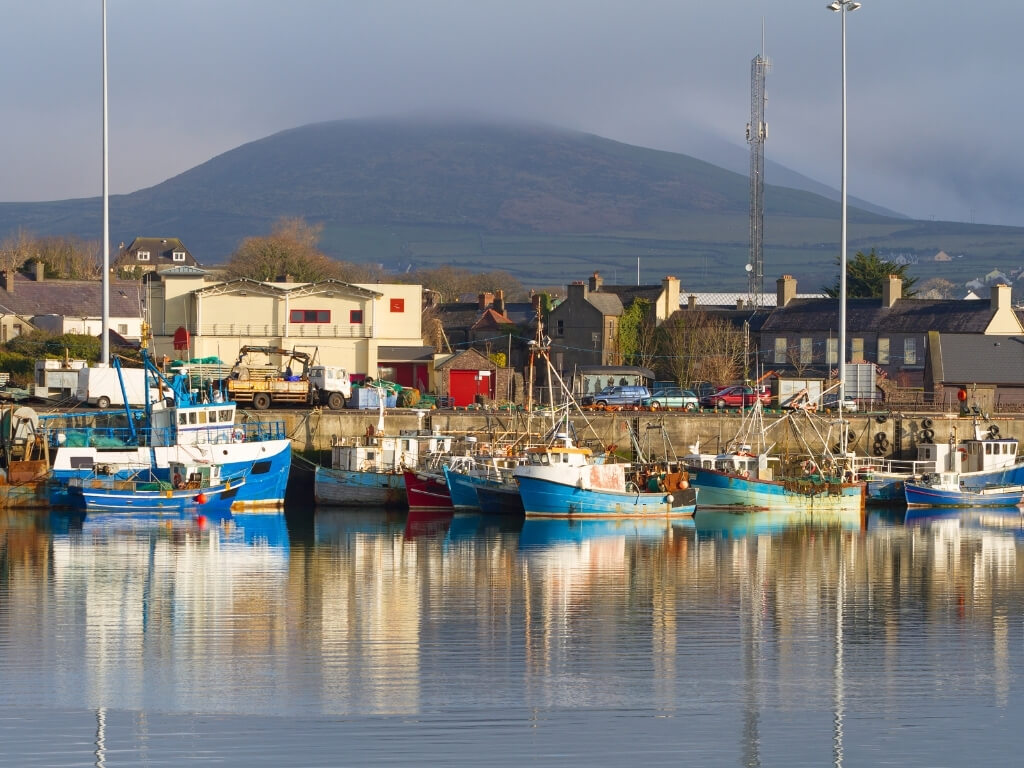
Day 4 – Bunratty to Galway
Today you will continue travelling north upon departing Bunratty and after this section of the Wild Atlantic Way, Galway will be your destination for your overnight stay. This section of the road trip is 255km long and will take approximately 4.75 hours at an average speed of under 50kph.
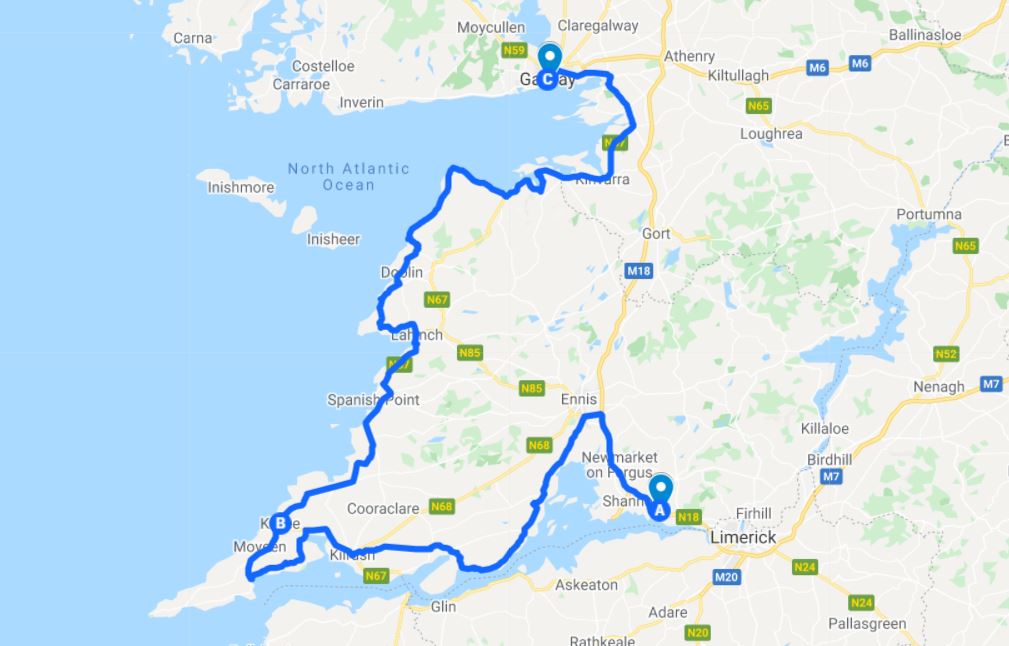
County Clare is known for its coastal scenery, none more popular than the Cliffs of Moher, the Wild Atlantic Way’s most famous signature discovery point. But this isn’t the only beautiful coastal area to visit along today’s route.
Leaving Bunratty, head west to Loop Head, a quiet but impressive section of the Wild Atlantic Way, where you will pass through Kilrush (you can visit the Shannon Dolphin and Wildlife Foundation visitor centre), Lahinch (popular with surfers), on past the Cliffs of Moher, through Doolin (a great base for exploring the Burren National Park and the Aran Islands) and Kinvarra (home to the Dunguaire Castle) before ending in Galway.
This section of the Wild Atlantic Way is mainly about seeing the Cliffs of Moher, so allow a few hours in your day for these. But they are not the only things to do in Clare along the Wild Atlantic Way.
- See the only remaining sea arch of the Bridges of Ross, near the small townland of the same name. There were three until not so long ago.
- Head to Loop Head to see Diarmuid and Gráinne’s Rock, a famous sea stack, before visiting the Loop Head Lighthouse.
- The small village of Doonbeg is home to a ruined castle.
- See the largest stalactite in the Northern Hemisphere in Doolin’s Cave.
- Spend time in the Burren National Park, famous for its Karst landscape.
- Visit the 13th-century Corcomroe Monastery near Ballyvaughan or the Poulnabrone Dolmen, an ancient portal tomb that attracts a few hundred thousand visitors every year.
Places to stay in Galway – One of the best budget-friendly hotels to stay in Galway is Jury’s Inn Hotel. Click here for the latest prices and availability. The Hardiman is also a great hotel located on Eyre Square. Check out this hotel, prices and availability here. Or for a luxury stay, why not book into the G Hotel, a 20-minute walk to Eyre Square. See this hotel and get the latest prices and availability here.
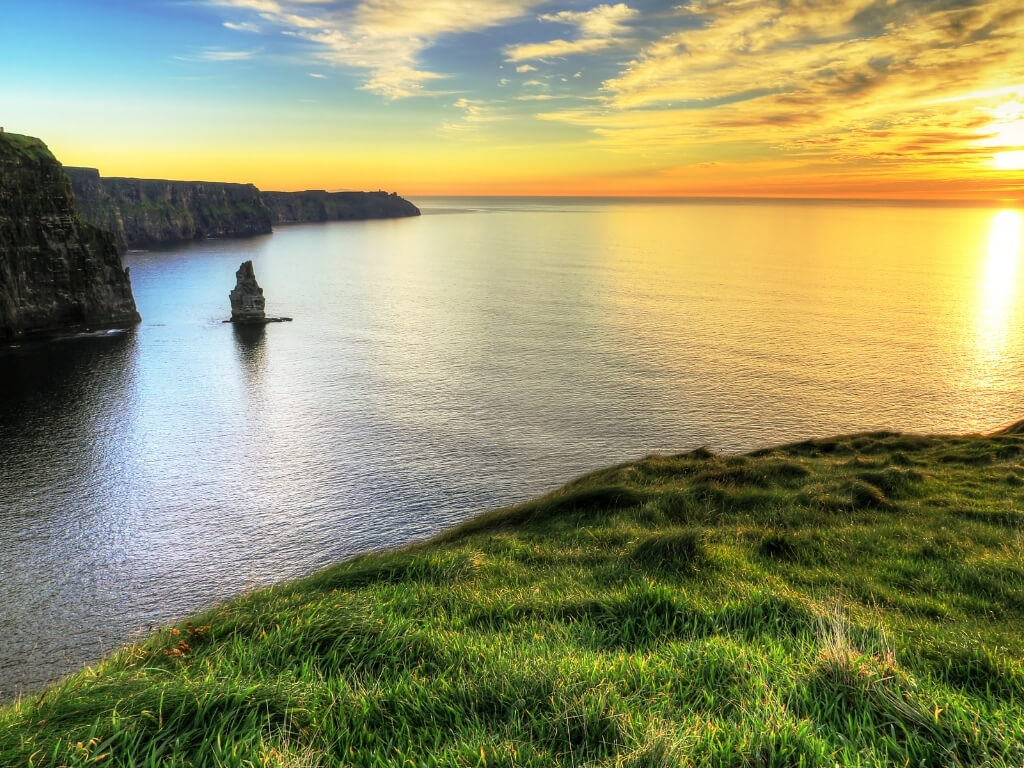
Day 5 – Galway to Westport (via Connemara)
Your final destination on this 5-day Wild Atlantic Way road trip will be Westport. Travelling through Connemara, this final section of the south Wild Atlantic Way itinerary will be approximately 252km, will take just over 5 hours without stops at an average speed of less than 50kph.
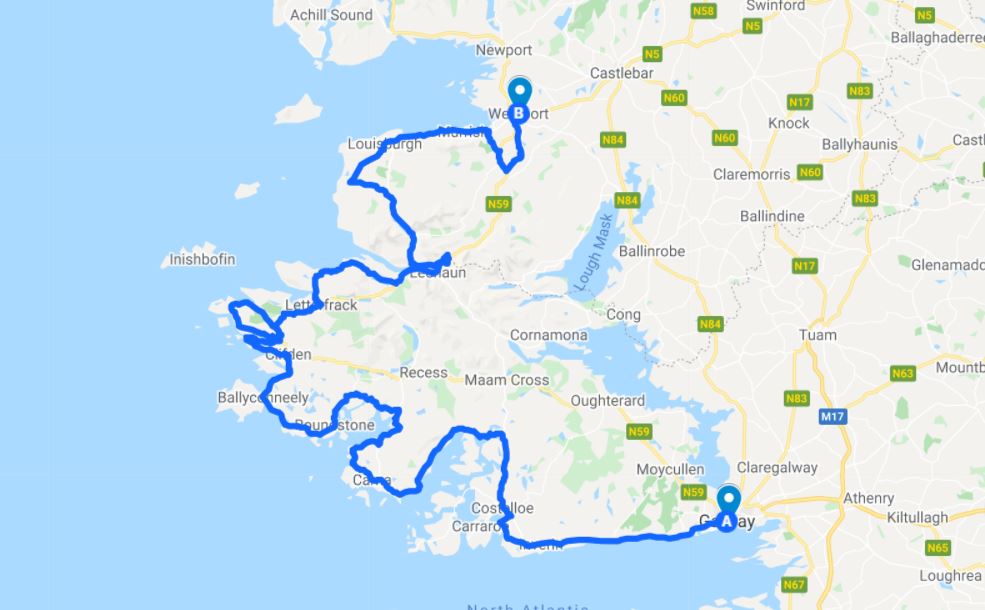
Galway is one of the top tourist destinations in Ireland and especially Connemara, the wild and rugged landscape that the vast majority of the coastline of the county lies within.
After departing Galway City, you will be driving west through Spiddal (a Gaeltacht town), Clifden (the unofficial capital of Connemara), and then on into County Mayo where Westport is your final destination.
This section of the Wild Atlantic Way weaves through Connemara so today is all about landscape and scenery. But there are still some great things to do in Galway along this section of the road trip that is worth factoring into your day.
- The Blue Flag beach of Salthill is lovely for swimming or walking. Visit either the night you arrive in Galway or the morning before you set off.
- Climb the 300-meter Errisbeg near Roundstone Village to enjoy the views all around.
- Detour into the Connemara National Park near Letterfrack or visit the stunning Kylemore Abbey.
- Just north of Doo Lough you can visit a Famine Memorial and admire the views down the valley.
- Croagh Patrick, considered the holiest mountain in Ireland, is located just off this section of the Wild Atlantic Way once you enter county Mayo. People regularly make pilgrimages here to climb the 764 meters to the summit. It may be better to do this on another day if staying a few nights in Westport as there won’t be enough time on this day to climb the mountain.
Places to stay in Westport – If you are looking for a great budget-friendly place to stay, then we recommend the Wyatt Hotel. Click here for prices and availability. But, if you are looking for a bit more luxury to end your Wild Atlantic Way trip, then check into the Westport Plaza Hotel. Find the latest prices and availability here.
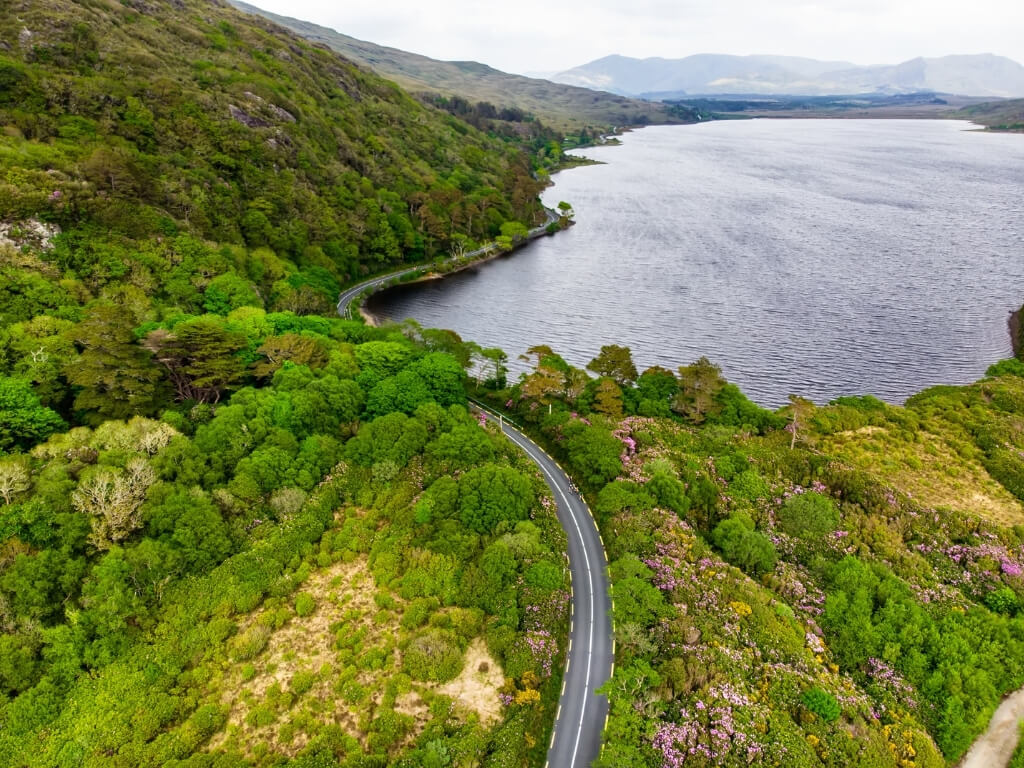
Final thoughts on the best of the Wild Atlantic Way in 5 days
There is a no better road trip to undertake than one that follows part of the Wild Atlantic Way. Ireland is a beautiful country with so many different landscapes and this amazing driving route is one of the best ways to see the changing scenery.
This itinerary for discovering some of the best parts of the Wild Atlantic Way in 5 days will allow you to immerse yourself in the country, discover history around every corner and allow you to enjoy the culture along the way. While you won’t see it all, you will certainly come away with memories to fill your heart and no doubt, Ireland will have taken hold of a part of your heart forever after this trip.
For more information about the Wild Atlantic Way, we recommend this book.
Read more about visiting Ireland and journeying along the Wild Atlantic Way:
- Causeway Coast and Wild Atlantic Way 7-Day Itinerary
- A Complete Guide to the Wild Atlantic Way
- Best Time to Visit Ireland
- Best Places to Visit in Ireland
- Best Coastal Towns in Ireland
- Best Beaches to Visit in Ireland
- How to Get Around Ireland
- What to Pack for Ireland
- Best Foods to Try in Ireland
- What Souvenirs to Buy in Ireland
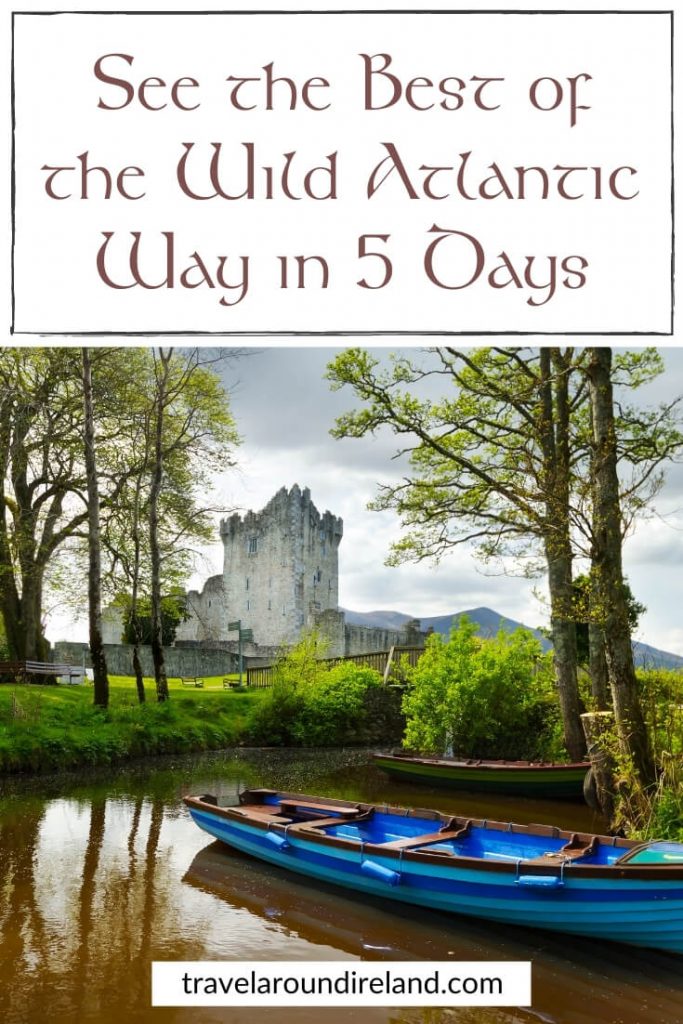
Travel Around Ireland is a participant in the Amazon Services LLC Associates Program, an affiliate advertising program designed to provide a means for sites to earn advertising fees by advertising and linking to amazon.com, amazon.co.uk, amazon.ca. Amazon and the Amazon logo are trademarks of Amazon.com, Inc. or its affiliates. To learn more about affiliate links, read my Disclosure Policy here.

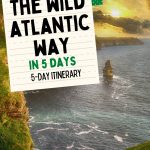

hi. ive found your maps really good to follow but have you a map of the final leg to donegal . i do know its not on the 5 day trip but i do intend to make it a 6 day trip, many thanks heres hoping, martin.
Hi Martin,
This post of mine has maps for the upper half of the Wild Atlantic Way in the first 2-3 maps. I’ll pop this link across to your email as well so you have it for reference:
https://travelaroundireland.com/causeway-coast-and-wild-atlantic-way-7-day-itinerary/
many thanks for your reply, i have followed your instructions and found what i needed. cant wait for next may.
Fantastic itinerary and article, Thanks Cath.
We were on a 5 day motorcycle trip and followed this guide. Was very useful as a route , and local attractions guide.
It was easy to miss (as we did )the wild Atlantic way around Limerick and Galway and have to go through the towns in traffic, which was not enjoyable. Not sure if the wild Atlantic way is actually continuous around these cities.
Ari, thank you for your kind words and for letting me know you found it helpful. My husband and I did part of the Wild Atlantic Way on our first honeymoon in 2010 before it was even the WAW. We’re hoping to go back next year with our son, albeit in a car.
For Limerick, it actually does not pass through the city but sort of stops at Foynes Island Viewpoint on the road from Kerry towards Limerick City, skips across the estuary and restarts at Killimer. So to get around the estuary, you have to go through the city unfortunately to pick up the WAW again.
With Galway, you cannot bypass the city as it does technically pass through the city to get to Salthill Promenade where it properly becomes the Wild Atlantic Way again.